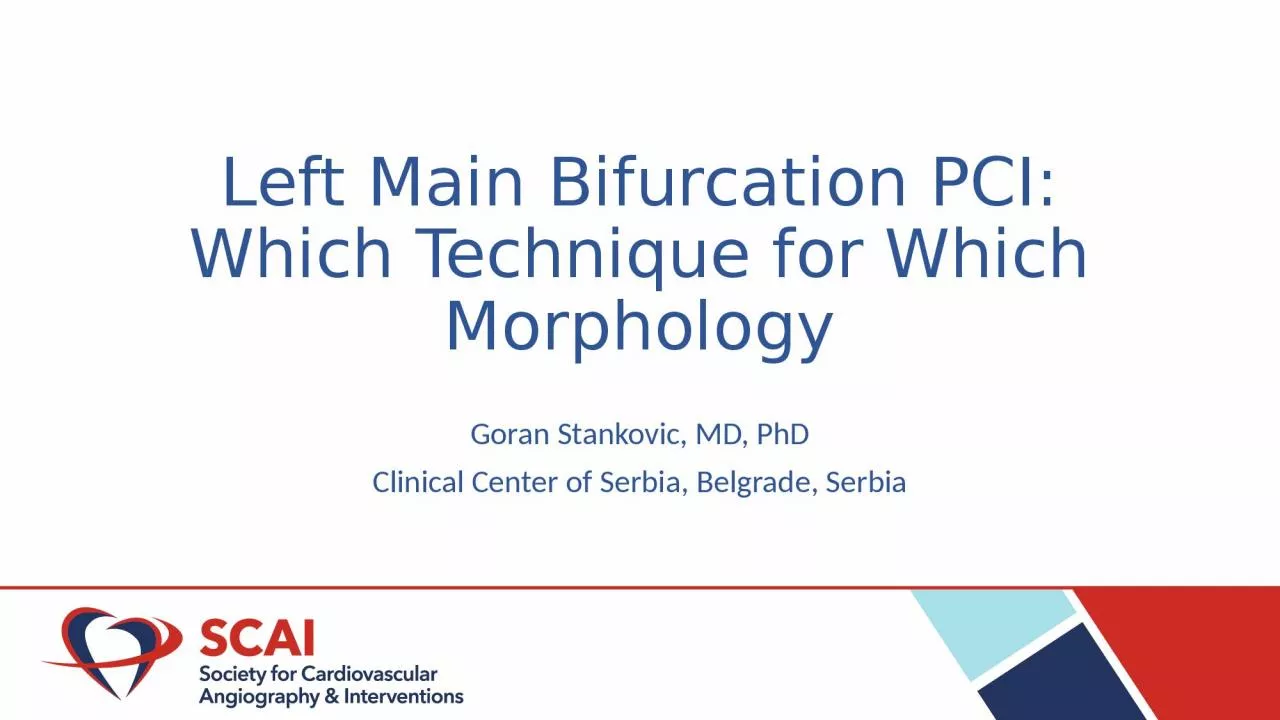

Goran Stankovic MD PhD Clinical Center of Serbia Belgrade Serbia Disclosures I Goran Stankovic DO NOT have a financial interest arrangements or affiliation with one or more organizations that could be perceived as a real or apparent conflict of interest in the context of the subject of ID: 935201
Download Presentation The PPT/PDF document "Left Main Bifurcation PCI: Which Techniq..." is the property of its rightful owner. Permission is granted to download and print the materials on this web site for personal, non-commercial use only, and to display it on your personal computer provided you do not modify the materials and that you retain all copyright notices contained in the materials. By downloading content from our website, you accept the terms of this agreement.
Slide1
Left Main Bifurcation PCI: Which Technique for Which Morphology
Goran Stankovic, MD, PhD
Clinical Center of Serbia, Belgrade, Serbia
Slide2Disclosures
I, Goran Stankovic, DO NOT have
a financial interest / arrangements or affiliation with one or more organizations that could be perceived as a real or apparent conflict of interest in the context of the subject of this presentation
Slide3T-shape angulation (B ∿ 80
o
)
Large MV: caliber discrepancy
Calcifications
Ostium involved
SB not smallTrifurcations in about 10%
Left Main Bifurcation Different
Modified from T. Lefevre
Medrano-Gracia et al. Euroint 2016;12:845-854
Slide4Bifurcation lesion with no disease proximal to the bifurcation or very short left main
Bifurcation lesion with MB disease extending proximal to bifurcation and SB which has origin with about 90°angle
Bifurcation lesion with MB disease extending proximal to bifurcation and SB which has origin with < 70°angle
V-Stent
T/TAP-Stenting
DK-Crush/
miniCulotte
Pre
Post
Pre
Post
Pre
Post
Planned 2-stent approach for LM bifurcation lesions: the size and extent of disease and its angulation
Courtesy of A. Colombo
Slide5EBC Consensus on LM PCI Techniques
EuroIntervention
. 2018 May 20;14(1):112-120
Slide6EBC Consensus on LM PCI Techniques
Provisional is recommended technique for distal LM disease not involving both branches;
Elective two-stent strategies may be considered for long LCX lesions, high risk of LCX compromise or difficult access;
In LM disease involving both branches stent technique should depend on individual patient’s anatomical characteristics and operator’s skill;
EuroIntervention
. 2018 May 20;14(1):112-120
Slide7EBC Consensus on LM PCI Techniques
When a planned two stent strategy is used, this should be done in a provisional stepwise approach to the lesion, finalizing the procedure using a T/TAP or a culotte technique (as a cross-over from the provisional);
For operators with appropriate experience, DK-Crush is a valuable option for complex left main bifurcation lesions;
EuroIntervention
. 2018 May 20;14(1):112-120
Slide8Major concerns regarding the SB after MB stenting
Modified from
EuroIntervention
. 2018 Jan 20;13(13):1540-1553
Main technical options for elective double stent implantation
Low risk of loosing the SB after MB stenting
MB stenting followed by planned SB implantation
POT, distal MB rewiring, MB dilation
Bifurcated lesion with extensive atherosclerotic involvement of both MB and (an important) SB
Slide9Major concerns regarding the SB after MB stenting
DK-CRUSH
POT, distal MB rewiring, MB dilation
Inv. Culotte Inv. Elective T Inv. TAP
Bifurcated lesion with extensive atherosclerotic involvement of both MB and (an important) SB
Modified from
EuroIntervention
. 2018 Jan 20;13(13):1540-1553
Low risk of loosing the SB after MB stenting
MB stenting followed by planned SB implantation
POT, distal MB rewiring, MB dilation
Provisional SB stent
Main technical options for elective double stent implantation
Inverted Provisional
Slide102018 ESC/EACTS Guidelines on myocardial revascularization
Eur
Heart J. 2018 Aug 25.
doi
: 10.1093/
eurheartj
/ehy394.
Slide11Target Lesion Failure (%)
Primary Endpoint
Target Lesion Failure
DKCRUSH V
Chen et al. JACC 2017; 70(21):2605-17
Slide12LM bifurcation lesion 111 or 011
482 randomized patients 1/1
PS (242)
DK Crush (240)
Predilation
MB 83.9%
SB 39.7% POT 98.8%
PredilationMB 75.4%SB 68.3%POT 99.2%SB Stent 47%SB stent 100%Final kissing 78.9%
Final kissing 99.6%
SB lesion length (mm)
16.6
+
11.9 16.2
+
14.0
SB lesion length > 10 mm
43% 50%
Strategy comparison in DK-Crush V
Chen et al. JACC 2017; 70(21):2605-17
Slide13Target Lesion Failure at 1-Year
Simple vs. Complex Bifurcation Lesions
DKCRUSH V
LCX-LL<10 mm
and/or
ost
. LCX DS <70%
Simple Lesions
1-year TLF (%)
1-year TLF (%)
Complex Lesions
8.0%
1.9%
18.2%
7.0%
HR 0.68, 95% CI 0.31-1.49
HR 0.27, 95% CI 0.05-0.54
LCX-LL ≥10 mm
and
ost
. LCX DS ≥70%
Plus ≥2 of 6 minor criteria
Chen et al. JACC 2017; 70(21):2605-17
Slide14EBC MAIN:
A European Bifurcation Club Trial
The
E
uropean
B
ifurcation
Club Left Main Coronary Study - a randomised comparison of Single versus Dual Stenting for True Bifurcation Left Main Coronary Lesions
Slide15EBC MAIN: Hypothesis
Left main coronary bifurcation lesions (type 1,1,1 or 0,1,1: both LAD and
Cx
>2.75mm diameter) are best treated with
a planned provisional single stent strategy rather than a planned dual stent strategy,
with respect to death, target lesion revascularisation and myocardial infarction at 1 year.”
Slide16Trial Status: the recruitment is completed the 01DEC2019.
Slide17LM has unique anatomical characteristics which demand different technical approaches compared with non-LM bifurcations;
A provisional SB stenting approach is recommended for LM treatment in most cases;
Elective two-stent strategies may be considered for long LCX lesions, high risk of LCX compromise or difficult access;
Conclusions
Slide18Stent technique should depend on individual patient’s anatomical characteristics and the operator’s skill;
Either T/TAP, culotte or DK crush could be used as a two stent technique;
Among two-stent techniques, strong randomized evidence available for DK-Crush, while EBC MAIN results are awaited;
Conclusions
Slide19Thank You
gorastan@gmail.com